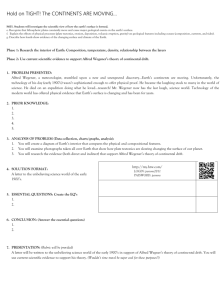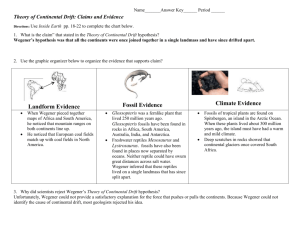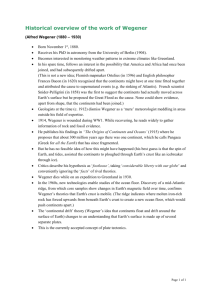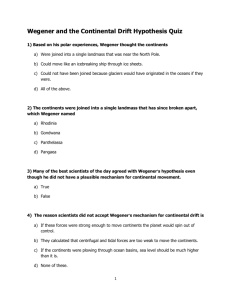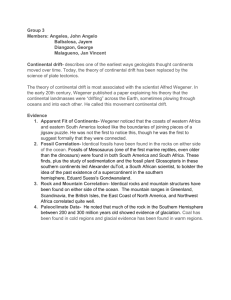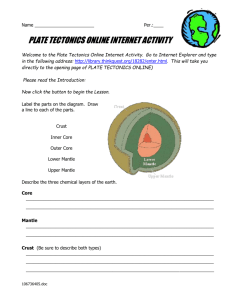Alfred Wegener - New Haven Science
advertisement
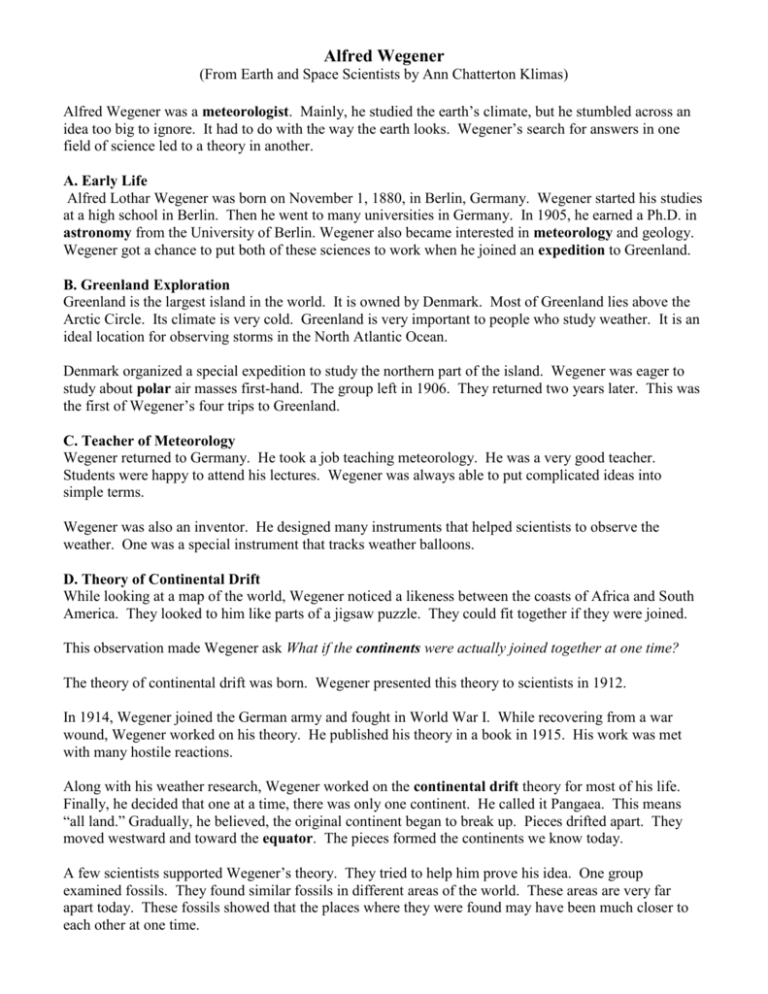
Alfred Wegener (From Earth and Space Scientists by Ann Chatterton Klimas) Alfred Wegener was a meteorologist. Mainly, he studied the earth’s climate, but he stumbled across an idea too big to ignore. It had to do with the way the earth looks. Wegener’s search for answers in one field of science led to a theory in another. A. Early Life Alfred Lothar Wegener was born on November 1, 1880, in Berlin, Germany. Wegener started his studies at a high school in Berlin. Then he went to many universities in Germany. In 1905, he earned a Ph.D. in astronomy from the University of Berlin. Wegener also became interested in meteorology and geology. Wegener got a chance to put both of these sciences to work when he joined an expedition to Greenland. B. Greenland Exploration Greenland is the largest island in the world. It is owned by Denmark. Most of Greenland lies above the Arctic Circle. Its climate is very cold. Greenland is very important to people who study weather. It is an ideal location for observing storms in the North Atlantic Ocean. Denmark organized a special expedition to study the northern part of the island. Wegener was eager to study about polar air masses first-hand. The group left in 1906. They returned two years later. This was the first of Wegener’s four trips to Greenland. C. Teacher of Meteorology Wegener returned to Germany. He took a job teaching meteorology. He was a very good teacher. Students were happy to attend his lectures. Wegener was always able to put complicated ideas into simple terms. Wegener was also an inventor. He designed many instruments that helped scientists to observe the weather. One was a special instrument that tracks weather balloons. D. Theory of Continental Drift While looking at a map of the world, Wegener noticed a likeness between the coasts of Africa and South America. They looked to him like parts of a jigsaw puzzle. They could fit together if they were joined. This observation made Wegener ask What if the continents were actually joined together at one time? The theory of continental drift was born. Wegener presented this theory to scientists in 1912. In 1914, Wegener joined the German army and fought in World War I. While recovering from a war wound, Wegener worked on his theory. He published his theory in a book in 1915. His work was met with many hostile reactions. Along with his weather research, Wegener worked on the continental drift theory for most of his life. Finally, he decided that one at a time, there was only one continent. He called it Pangaea. This means “all land.” Gradually, he believed, the original continent began to break up. Pieces drifted apart. They moved westward and toward the equator. The pieces formed the continents we know today. A few scientists supported Wegener’s theory. They tried to help him prove his idea. One group examined fossils. They found similar fossils in different areas of the world. These areas are very far apart today. These fossils showed that the places where they were found may have been much closer to each other at one time. More proof was discovered by scientists who used radiocarbon dating. They found rocks in Africa and South America that were the same age and type. Scientists studying the earth’s magnetism came up with a third proof. They found that the magnetic fields of some rocks were not as expected. It did not appear that the rocks were formed in their current location. This observation convinced them that the continents where these rocks were formed had moved. Despite this evidence, many scientists did not accept Wegener’s theory. Wegener did not live long enough to see all the controversy. He died at the age of 50, while on another expedition to Greenland. He disappeared after going alone to deliver supplies to coworkers. His body was found the following summer. Summary Alfred Wegener believed that the continents had drifted to their modern locations. At the time, many scientists laughed at his idea. Today, the theory of continental drift is still debated. Many scientists now believe that many parts of Wegener’s theory are correct. Match each definition with the correct word. ____1. imaginary line around the center of the earth ____2. main land mass on the earth a. continent ____3. scientist who studies climate and weather c. polar ____4. force of attraction between objects d. meteorologist ____5. planned working trip e. equator ____6. related to the regions at the earth’s north and south poles f. magnetism b. expedition Answer the questions below. 1. Did Wegener use his college degree in his work? Use details from the story to explain your reasoning. 2. Why do you think most scientists did not accept Wegener’s theory? Complete the graphic organizer below using information from the article. scientist: D. A. B. Main Idea: C.
